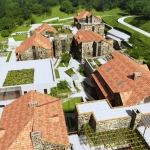Armenia’s historical roots date back to the remotest past of the Middle East. Armenia came out on the historical stage as a direct heir to the old Eastern civilizations, as a successor to their social-political, cultural and spiritual wealth and traditions. Armenia’s place and role in the political system of the East lies in the inheritance of those civilizations. Greek historians Herodotus and Xenophon, (5th century B.C.) describe Armenia as a vast and prospering country. They describe Armenians as having highly well-developed agriculture and trades. During the Hellenistic period (4th-1st centuries B.C.) Armenia appeared to be the only country in the East, which independently without Greek-Macedonian conqueror’s intervention adopted the elements of the Hellenistic civilization: Armenian kings founded self-governing towns with multi-national population. Armenian elite had access to the Hellenistic culture, theatre and arts. Armenian King Tigran the Great (95-55 B.C.) having united under his dominion considerable parts of the Middle East was carrying out a policy of rapprochement of local peoples. He understood well enough that the key to securing of the Armenian regions unity in the struggle against the expansionist policy of the Roman Empire would be through overcoming the estrangement between Greeks and Easterners. The peculiarity of Armenia’s fate was its location between the then super powers, which embodied quite opposite civilizations Western and Eastern. Under constant military-political as well as cultural-ideological clashes, it was urgent to maintain Armenian national and cultural identity and political integrity. Armenia found a fulcrum for its religious, ideological and cultural cohesion in Christianity. By adopting it in 301 AD as a state religion, Armenian king Tiridates III confirmed his country’s political and ideological independence from the pagan Roman Empire. And the creation of an Armenian alphabet by Mesrop Mashtots in 405 gave rise to Armenian Christian culture in the 5th century, becoming thus a powerful support for strengthening national self-consciousness. Church architecture, sharakans (spiritual psalms), secular and spiritual poetry, khachkars (stone crosses) – masterpieces of the original national art, all this creates a unique image of Armenia. Armenian Medieval conceptions were focused on the Christian spirituality, heritage of ancient philosophy as well as on the scientific interest towards the material world. In the 10th century, during the reign of the Bagratuni and Artsruni dynasties, the Armenian Medieval civilization flourished. Its social-economic base became Ani, Kars, Artsn and other rich trading cities. A pre-Renaissance comprehension of the world was maturing here. Situated at the crossroad of the Greek-Byzantine and Islamic-Arabic-Iranian worlds, Armenia was actively communicating with both. However, an irreparable blow was inflicted to Armenian Medieval civilization in the 11th-14th centuries by nomadic tribes from Central Asia – Turk-Seljuks, Mongols and other invaders. The nomads razed towns, killed the peaceful population and destroyed cultural monuments. During the next centuries (XIV-XIX). despite the loss of their political sovereignity, Armenians succeeded to preserve and develop their ancient culture which originality was based on the mutual synthesis of the elements of both Eastern and Western civilizations.
Ruben Manaseryan










